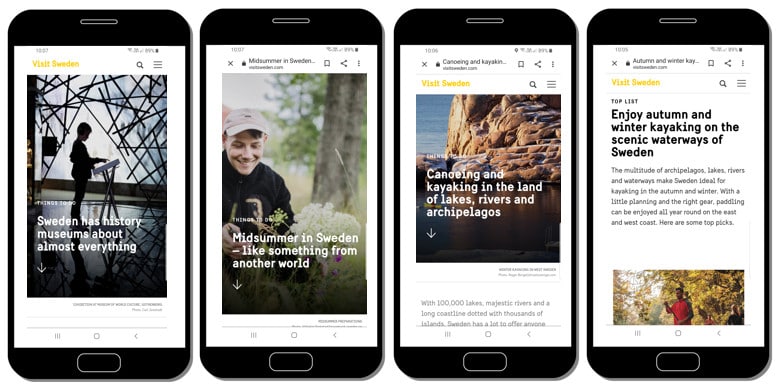Visit Sweden är statens marknadsföringsbolag för den svenska tursitnäringen. På sin webbplats samlar man information om Sverige som resmål och tipsar om platser, händelser och allt man kan göra som turist. Vi fick i uppdrag att skriva en rad artiklar om Canoeing & Kayaking, historiska museer och hur man firar en typiskt svensk midsommar.
Korta utdrag ur artiklarna:
Canoeing & Kayaking
With 100,000 lakes, majestic rivers, and a long coastline dotted with thousands of islands, Sweden has a lot to offer anyone loving adventures on water, regardless of experience. From north to south, there are a vast array of choices for canoeing or kayaking, including city paddling in Stockholm, Gothenburg and Malmö. Few leisure activities are as fun and accessible for beginners and hardcore enthusiasts alike as canoeing and kayaking. Whether you’d prefer to explore Sweden’s waterways with an experienced guide or take a solo tour through the canals in one of the three largest cities, canoeing and kayaking in Sweden have never been easier.
Northern Sweden: Glide the wild rivers towards the sea
Swedish Lapland is home to the country’s wildest rivers. The Torne, Ume, Kalix, and Lule rivers offer canoeists and kayakers a true wilderness experience as the waterways cut through ravines across giant Arctic plains and marshes on their way to the Gulf of Bothnia. River canoeing doesn’t get any wilder than this! The highest coastline in the world, Höga Kusten, beckons you to go kayaking or stand up paddleboarding along this magnificent Unesco World Heritage site. Here, above the Arctic Circle, the midnight sun lights up the sky 24/7 in the summertime giving you double the time to explore this extraordinary and dramatic landscape and beautiful archipelago.
Autumn and winter kayaking
The multitude of archipelagos, lakes, rivers and waterways make Sweden ideal for kayaking in the autumn and winter. With a little planning and the right gear, paddling can be enjoyed all year round on the east and west coast. Here are some top picks. The calm river Fylleån in the Halland region on the west coast of Sweden is great for stand-up paddling (SUP) enthusiasts year-round. Your adventure begins in Snöstorp east of Halmstad where the river gently meanders to the sea. If you love kayaking and canoeing, SUP is an experience for you to try. Paddling off-season has the added advantage of less traffic on the river. There are plenty of kayaking options in the spectacular Roslagen archipelago on the east coast. Courses for beginners, equipment rentals and guided adventure tours await bold fun-seekers. A good starting point is the tranquil island of Rävsten featuring sea kayaking, stand-up paddle boarding and fishing kayaks, where you sit on top (SOT). These stable kayaks are fun and easy to use.
Historic Museums
Sweden offers museums with various historical orientations. All over the country, museums bring history to life – not only from Sweden but from around the world. There is a large variety of historical museums of all categories and sizes in Sweden. Visitors will find museums about everything from natural history to architecture and design. Some museums focus on royal or military history while others highlight the historical and cultural heritage of nations around the world. There are four National Museums of World Culture in Sweden, which share the international history of mankind from an ethnographic and anthropological perspective.
- Museum of World Culture (Världskulturmuseet) in Gothenburg
- Museum of Ethnography (Etnografiska museet) in Stockholm
- Museum of Far Eastern Antiquities (Östasiatiska museet) in Stockholm
- Museum of Mediterranean and Near Eastern Antiquities (Medelhavsmuseet) in Stockholm
Midsummer in Sweden
Midsummer is here and all over the country, Swedes are getting ready to celebrate. Everyone is welcome to join in the fun. Or why not organise your own midsummer party. Here’s how! Sweden’s National Day is June 6, but midsummer (June 19-25) is when Swedes truly celebrate. This year, Midsummer Eve falls on June 21 but in many places, festivities are held on Midsummer Day on June 22. You are welcome to join in the celebration!
Midsummer night is filled with magic
The Christian tradition of celebrating the prophet St. John the Baptist on June 24 coincides with the summer solstice. In Northern Europe, the date is still celebrated with the lighting of bonfires and festivities. From the late Middle Ages, Swedes began raising and dancing around a midsummer pole. Decorating it with flowers and greenery is called ‘maja’, so it is also known as a maypole. In the agrarian society, the midsummer night was considered a time of magic and mystery when plants acquired healing powers and were used to predict the future. Young women would pick seven different kinds of flowers and put under their pillow to dream of their future husband. The flowers must be picked in silence, or the magic would be broken. Regardless of gender and norms, those feeling curious and intrigued should probably take a chance on this midsummer magic, it might just work.
Walking barefoot in the dew as the midsummer night turned to dawn helped you stay healthy. Wearing a wreath of flowers in your hair is an old symbol of rebirth and fertility. To preserve the flowers’ magic throughout the year, bouquets were dried and sometimes placed in the Christmas bath to keep the family healthy through the long, cold winter. Today, midsummer is about celebrating that the best time of the year lies ahead of us.
